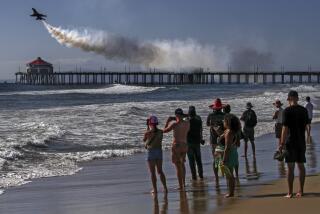Stage Is Set for El Toro Air Show’s Final Thundering Act
- Share via
In a few days, the airspace above El Toro Marine Corps Air Station will be slashed by thundering jets, stroked by gentle gliders and seared again by the staged-but-sinister dogfights that for 47 years have thrilled and inspired millions of spectators below.
As they have for decades, the Blue Angels will swirl and twirl in their famous blue jets, and the ominous Air Force Stealth bomber is sure to rattle nerves as it roars overhead.
Precision skydivers will drop magically from the clouds. Military hymns and the playing of the national anthem will draw tears from faithful veterans, prompting hundreds of crisp salutes to Old Glory.
And then, when it’s finally over, it will be--forever.
The skies that have hosted the annual El Toro Air Show since Harry S. Truman was president and television sets were a luxury will soon be streaked with only memories of the “biggest free show in Southern California.”
Because the base is set to close before 1999 and surrender to civilian control, the three-day air display at El Toro next weekend will be its last.
Pilots and base officials anticipating the bittersweet performance are mourning the loss of an event rich in history and tradition, an air show they proudly refer to as the “grand-daddy of them all.”
“Being in El Toro’s show really says something, because they don’t ask just anybody to perform,” said John Collver, a Lomita pilot who for 13 years has flown a 1944 SNJ aircraft at the show. “Losing it is going to put a real hole in the year for a lot of pilots.”
Larry Mutz, a civilian who has helped coordinate the air show for 17 years, said Orange County is facing a “sad spring” in 1998.
“There will be a void, I know,” said Mutz, 50. “You just can’t replace such a treasured tradition.”
Indeed, the popular show at El Toro has never been canceled.
Over the years, the event has seen tragedy in the form of two deadly crashes and a third, near-fatal one, but it continued to thrive nonetheless. Neither wilting heat, nor fuel shortages, inclement weather or weary neighbors, who complained regularly--and loudly--about the noise, ever stopped the show from taking off.
When the American raid on Libya in 1986 resulted in bomb threats and prompted other military bases to shut down their air shows, El Toro commanders vowed not to “live with a siege mentality.”
Similarly, when three men were killed in two air show crashes, base officials refused to send visitors home “shaking their heads” and had performers back in the air within minutes. A third crash in 1988 left another pilot critically injured.
“We have witnessed tragedy firsthand, before thousands of visitors who will never forget,” said Col. Jim Cranford, the base’s air show chairman. “But not even those [crashes], as any pilot will tell you, can overshadow the joy . . . the emotion and patriotism, that we have also seen at this event.”
And so the show, as always, went on. It grew too, bursting finally into a logistic nightmare for California Highway Patrol officers trying to manage five-mile-long traffic jams on three freeways.
By 1980, hourlong delays to get into the base and persistent rubbernecking became synonymous with the air show. The CHP “will probably be more relieved than most when the show is over for good,” said Marine Sgt. Barry Pawelek, a base spokesman.
Organizers of the country’s largest air show have also felt its growing pains, struggling each year to better accommodate the more than 1 million visitors who have tilted their faces to the sky.
More parking, water stations and toilets were added, and a mini RV park was created so campers could stay on base over the weekend. In 1993, the first grandstand seating was erected to replace the original wooden risers; now the grandstands and the new “four star” seating area hold more than 25,000 people.
No matter how hard they tried to keep up with the show’s attendance boom, however, a popularity explosion in 1988 made base officials learn quickly from planning mistakes.
When skateboarders started using a drainage ditch near the runway as a practice bowl, they were banned from the show. An increase in heart attacks, heat exhaustion and lost children resulted in more first-aid stations. And a massive swarm of bees one year has kept officials armed with pest controllers ever since.
At the 1991 show, organizers had to prepare for a then-record crowd of 1.2 million as more than 8,000 Marines were making their way back to El Toro and Tustin from the Persian Gulf War, riding a wave of public support. Last year, more than 1.6 million came, breaking the attendance record for the sixth time in eight years. This year’s show is expected to draw 2 million visitors.
Bret Willat, who will fly his sailplane at the base for the seventh time next weekend, said El Toro has been unlike most military air performances because it encourages diversity rather than “just a bunch of loud, macho, jets.”
“I have always been impressed by the quality of this show,” he said.
Faithful air show visitors agree. Virginia Lewis, 88, said she vowed 10 years ago to come to the show “until I die.”
“I never figured I would be around longer than it would,” said Lewis, of Anaheim. “Kind of makes me feel a little old.”
Staff librarian Sheila Kern also contributed to this story.
More to Read
Sign up for Essential California
The most important California stories and recommendations in your inbox every morning.
You may occasionally receive promotional content from the Los Angeles Times.










